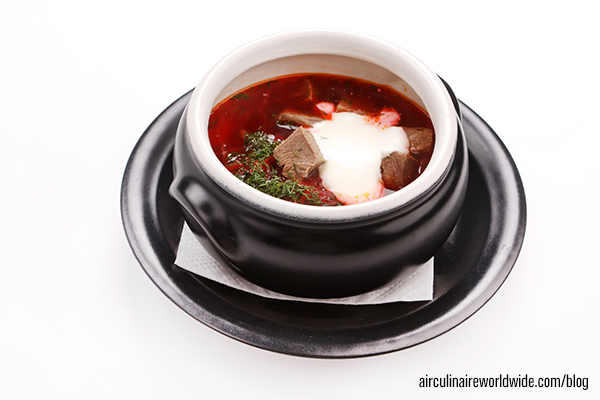My introduction to Russian cuisine began over eight years ago, when I was invited to dinner at the home of a friend and co-worker from where I was working as a grill cook. Her family was from a large and very diverse city, named Kharkiv, in Eastern Ukraine. However, like many who lived in that region of the country, they spoke and considered themselves ethnically Russian. Upon my arrival, I remember seeing a vibrant and colorful array of foods spread across the table, and I recall being caught completely off guard because my knowledge and exposure to the foods of that region was limited to my pathetic attempt at making chicken Kiev in culinary school and eating beef stroganoff at a company meal.
The chef for this meal was the mother of my friend, and it was clear she was very talented as the selection of items she prepared showed skills in pastry, garde manger and a versatile knowledge of hot food cookery. Carefully presented and displayed in front of me was something indicative of a much broader and tastier culinary scope and skill than I anticipated. It was rustic, yet refined in its own way and packed a myriad of flavors with each successive taste. It showed me how diverse the food of Russia truly was, as the influence of the former Soviet states was visually and flavorfully apparent with its all-encompassing use of spices and flavor profiles stretching across Europe and Central Asia. I was hooked, and wondered how I would be able to get myself over there for dinner again.
The star of the show that late afternoon was a soup that often is mistaken as being Russian in origin. However, by many historical accounts is a true Ukrainian dish that has become so popular among the people of Eastern Europe that it knows no political or geographical boundaries. This soup has been adopted by the people of Russia, Poland, Lithuania, Israel and other countries in Eastern Europe. The true beauty of borscht is that it is extremely versatile, with multiple variations (hot, cold, red or green) with the stock being made with beef, ham, chicken or duck. There are also vegetarian versions, based on mushroom stock, that are complemented with vegetables like cabbage, potato, haricots vert, tomato, carrot, apple, turnip, pea pods, green and red pepper and sweet corn. Other flavoring can come from onions, garlic, pepper, angelica leaves, caraway, dill, marjoram, thyme parsley or celery.
After that initial dinner, my now wife and I have twice traveled back to her former country of Ukraine. We have toured Kiev and Moscow, and have vacationed on the beaches of Crimea. Along the way, I’ve had some fantastic meals in some very interesting locales. Not many have lived up to my introductory meal, and luckily I was invited back to their house a few more times. Now I’m spoiled and can get any of those items by just merely picking up the phone and asking, but should you be visiting Moscow or anywhere else in Russia, you are sure to find an amazing bowl of borscht at just about any restaurant you walk into.
The recipe below is for a traditional borscht, very similar to the one my now mother-in-law prepared that evening.
Ingredients
- 1 pound (450 g) beef brisket or flank, to produce 3 pints of stock
- 1-2 tablespoons (15-30 mL) oil
- 1 large raw beetroot (10 ounces)
- 1 tablespoon (15mL) vinegar
- 2 ounces bacon fat
- 2 teaspoons (10g) sugar
- 2-3 teaspoons (10-15 g) tomato puree or 2 whole tomatoes
- 2 onions
- 2 carrots
- 2 stalks celery
- ½ cup (120 mL) water
- 1 parsley root or ½ a parsnip
- 1 ounce butter
- 10 ounce Dutch cabbage
- 12 ounces – 1 pound (450 g) of potatoes
- 10 peppercorns
- 3 allspice berries
- 6 bay leaves
- ½ – 1 head garlic
- Fresh chopped parsley
- Salt, to taste
- Beetroot brine, to taste
- Sour cream, for garnish
Method – Stock
- Sear beef in roasting pan, turning occasionally, until browned. Cut carrot and celery stalks into 3 inch (7.5 cm) pieces. Add to pan along with one chopped onion and two cloves of garlic. Turn occasionally, until vegetables are brown, for 20-25 minutes.
- Transfer to a large stockpot; add cold water to cover. Pour off fat from pan, add ½ cup (120 mL) water and stir, scraping up browned bits. Add three bay leaves and five black peppercorns. Bring to a boil, reduce heat and simmer 4 hours. Occasionally skim foam and fat from surface and add water as needed. Strain and cool.
Method – Borscht
- Put chopped beetroot in a large pot with vinegar, ½ of bacon fat, sugar, and tomato puree.
- Cook gently with the lid on until fork-tender.
- Fine chop remaining onions, carrot and parsley root. Braise in butter on low-heat for 20 – 30 minutes.
- Chop cabbage, then cut potatoes into ¾ inch cubes and simmer in prepared stock for 15 minutes. Add beetroot, braised vegetables, peppercorns, allspice and bay leaves, then cook for 15-20 minutes. Finish with minced garlic, remaining bacon fat and parsley.
- Let cool in a refrigerator for 24 hours, as this allows for all flavors to come together.
- Before serving, season again with salt and pepper (to taste) and add a tablespoon of beetroot brine to heighten the flavor and color.
- Borscht is traditionally eaten with a dollop of sour cream, but it is not necessary in order to appreciate the full flavor profile of the meal.
This recipe can be varied according to whatever vegetables and stock you have on hand, provided the beetroot is present. It is also recommended to make sure to account for the bacon fat and the garlic, as they are considered essentials to good borscht.
Questions?
If you have any questions about in-flight catering, contact weborders@airculinaire.com.
Enjoyed making this recipe? Follow us on Instagram or Twitter and tag your culinary creations with #ACWrecipes. Have questions? Tweet @airculinaire.






